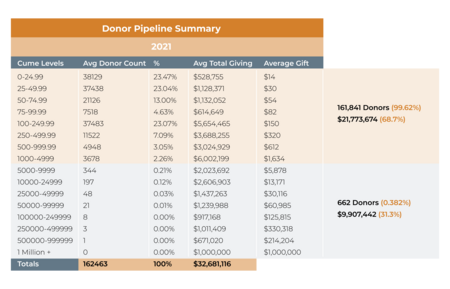Here’s a donor pipeline and an example of what not to do in fundraising. The numbers show active donors in range-of-giving categories. It is a perfect example of a dying major gifts pipeline.

There are several things to note here.
99.62% of the total donors – 161,841 of them – are clustered below the $5,000-total-giving-per-year level, while only 662 donors or 0.38% of the total are giving above the $5,000-a-year level.
While it is impressive that only 662 donors are giving almost one-third of the total (31.3%) or almost $10 million, this entire pipeline is upside down in value. The top half of the pipeline – $5,000 plus – should be delivering 50-65% of the revenue.
Here is why this one point is so important.
The bottom half of the donor pipeline, from acquisition through general cultivation has a much lower return on investment than the top half – mid-level, major, and planned giving.
So, if a leader does not manage investments and activity in fundraising with this one point in mind, he or she will produce an economic situation for their non-profit that:
- Delivers less net revenue for program.
- Produces worse overhead (admin and fundraising) ratios.
This is not a good way to operate. Jeff and I see these kinds of dysfunctional pipelines all the time. And they look exactly like the one above. And every one of the pipelines we look at, that looks like the one above, we quickly label as a dying major gift pipeline. It’s dying because most of the effort and fundraising investment is going to donor acquisition and general cultivation, while hardly any of it is going to mid-level and above. Which means that many of the donors acquired are going away and/or giving less.
This situation is a major waste of donor money and very poor stewardship on the part of the leadership of this organization. No one in the organization is “feeding the pipeline.”
Here is what feeding the major gifts pipeline means:
- Making a balanced investment in your fundraising so that the donors you acquire are properly cultivated, then moved to mid-level and invited to move into the major donor and planned giving levels.
- Not allowing any revenue stream or revenue source manager to control the investment agenda of the organization. Speaking plainly, this means you do not allow the direct marketing manager or the relationship fundraising manager to decide fundraising investments and priorities. Jeff and I have seen so many situations over the years where one strong personality drives investment and staffing decisions to favor themselves and their agenda. This is not good.
How is your organization doing at feeding the major gifts pipeline? Ask yourself these questions:
- Is there one revenue stream manager who drives the entire fundraising agenda – who gobbles up a majority of the fundraising budget?
- Are you struggling to get management to approve the hiring of more mid-level or major gift frontline fundraisers, even though you know the donor file has the donors in it to keep new hires busy and productive?
- Are you pressured to get a major gift or mid-level program going, when you know there is not a working and effective donor acquisition program in place in your organization? You know, the whole “just go out there and find some rich people to donate to us” thing. Jeff and I see this type of situation frequently, where an authority figure just “has to get a major gift program going” but has not provided the donors (from acquisition and cultivation) to properly populate productive caseloads.
If you are in any of the situations, speak up. Because staying silent and working in any of these scenarios will not be good for you or the organization. The fact is that you need balance to properly manage a healthy donor pipeline. And balance is often hard to find.
Richard







I am just beginning our Major Gifts program. Our organization has a lot of small donors, but very few large donors. The large donors we do have are being kept by the CEO of the organization.
So, in beginning my Major Gifts program, I am therefore trying to cultivate the smaller donors. How quickly can smaller donors become mid-level and then how quickly can mid-level become Major Donors?
I guess I need some sort of goal setting to understand how long a process this is going to take, so as not to get discouraged.
Thanks.
This is a great question. If you’re just starting to build a major gifts program, it can take 6-8 months to create a full caseload of 150 donors. But your program’s maturity, and therefore ROI, is dependent on a number of factors. It’s safe to assume that as you start, you’ll have an ROI of around 1:2 or 1:3, comparable with direct mail cultivation efforts. But as you continue to implement the plan and system, you’ll see that grow and mature. You should definitely explore some of our White Papers on qualification, creating strategic goals and plans, and how to start a major gifts program to learn more!